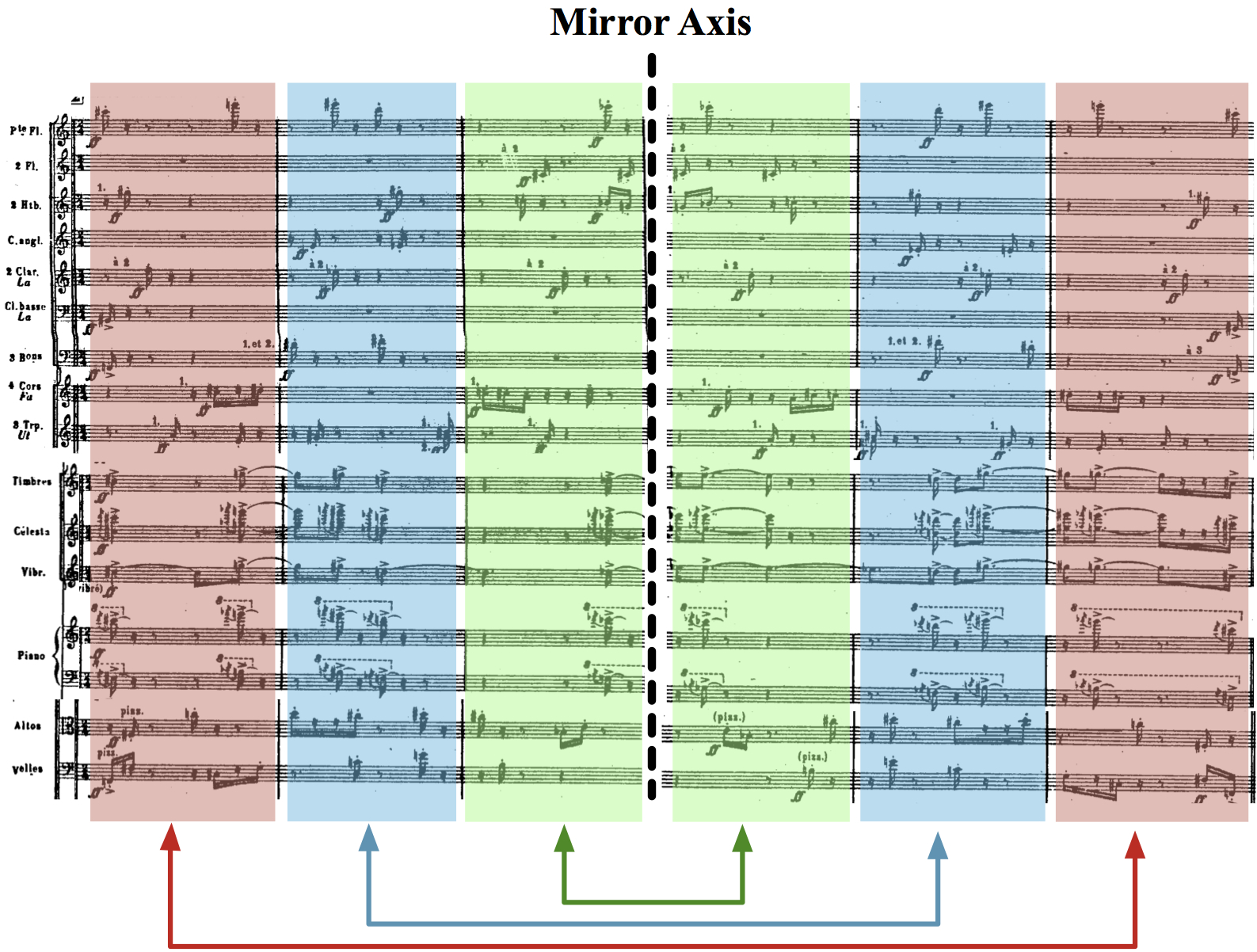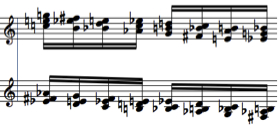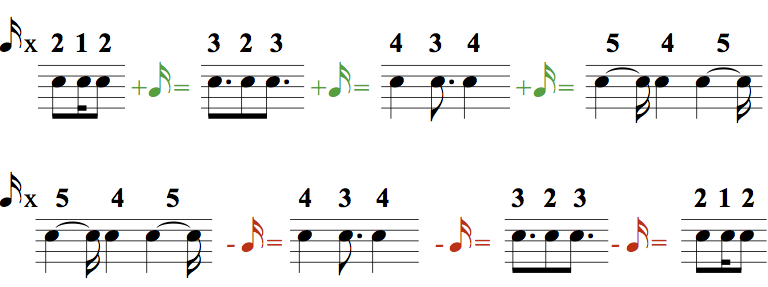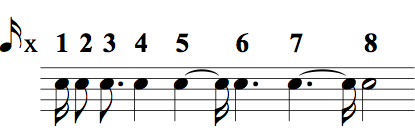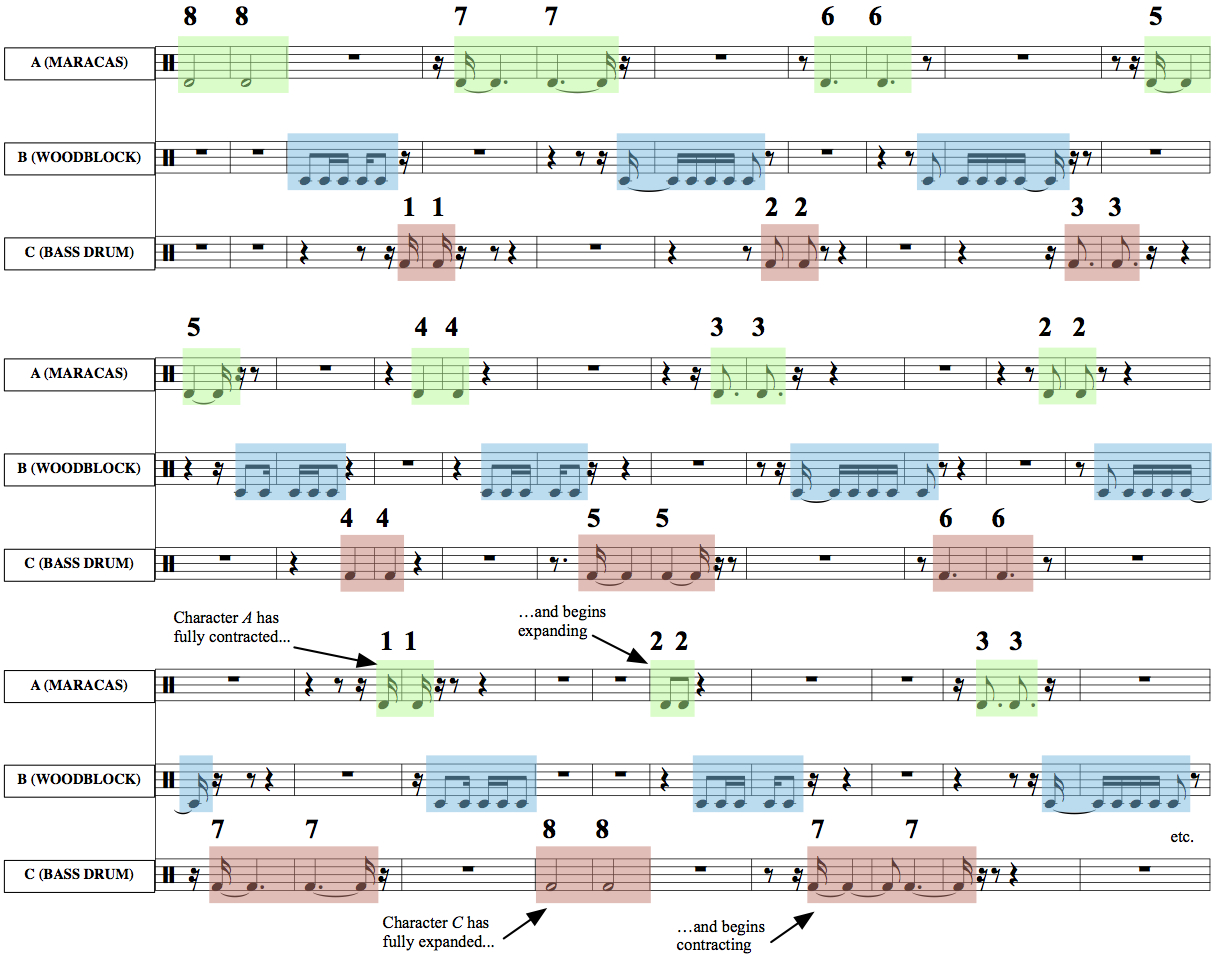PART 1: INTRODUCTION
The eighth movement opens up in a mood very similar to that of the seventh movement. At this point, it is difficult to see why Messiaen calls this movement "The Development of Love" -- it sounds much more like the gates of hell opening up!Some highlights of this section follow.
Diminishing Non-Retrogradable Rhythm
We have a repeated non-retrogradable rhythm of sixteenth note values {5-7-10-7-5} which gets diminished by one sixteenth note on each repetition. It is played by bass clarinet, 3rd bassoon, cymbals, gong, tubular bells, and basses (pizzicato). While it isn't exactly the "Statue Theme", the contours of the notes are the same as the "Statue Theme". |
| One cycle of the non-retrogradable rhythm. It gets diminished by one sixteenth note on each iteration. Click on image to enlarge. |
The "Chord Theme"
There are two simultaneous appearances of the "Chord Theme". First, we hear the piano play the four chords repeatedly in a rhythm {4-4-3-3}, thrown about the instrument's registers and accompanied by maracas and vibraphone resonances. |
| The "Chord Theme" as played by the solo piano. Click on image to enlarge. |
Shortly after, a very dense and spread-out orchestration of the "Chord Theme" enters in sixteenth notes played by 2 oboes, English horn, 2 clarinets, 2 bassoons, 2 horns, cornet, temple blocks, celesta, glockenspiel, violins, violas, and cellos.
Heh, it actually kind of sounds like the theme from Twilight Zone when it is heard by itself.
PART 2: THROUGH FIRST CLIMAX
The transition from part 1 to part 2 is about as abrupt as it gets in terms of musical mood swings. Immediately following the terrifying last note of part 1, we have a new theme that seems to be a sort-of fast variant of the "Love Theme" -- we will refer to it as the "Joyous Theme" (this is not the same as the "Joyous Theme" in the fifth movement).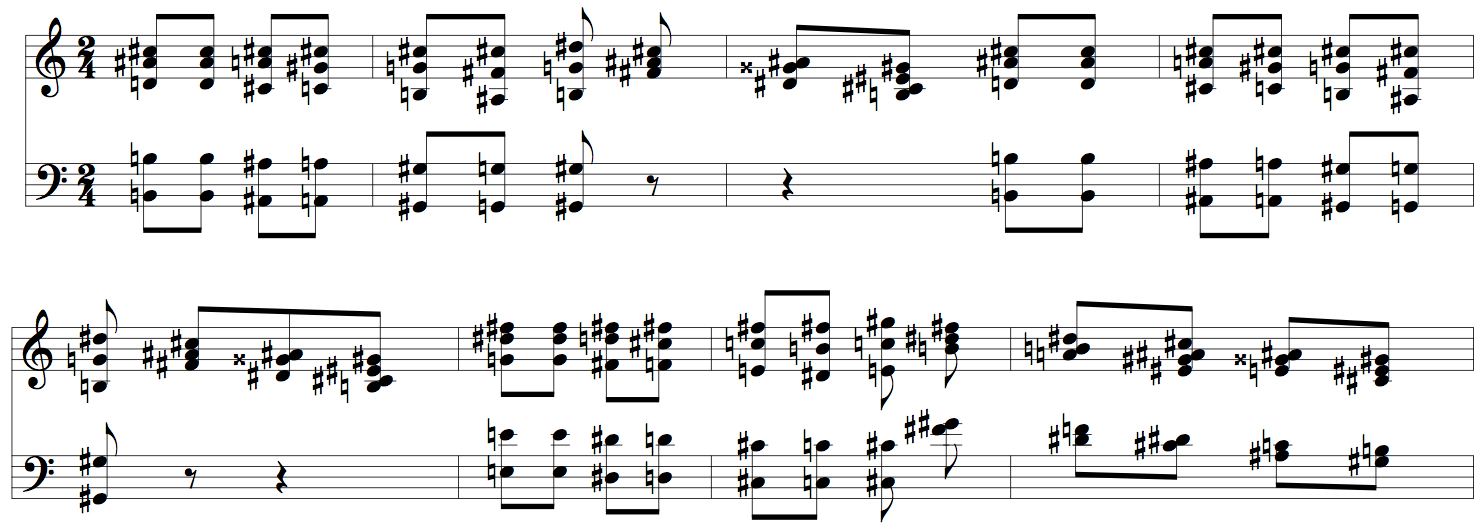 |
| The "Joyous Theme" occurs throughout the rest of the movement in various transpositions. Click on image to enlarge. |
Superimposed with the "Joyous Theme" is the "Chord Theme", hammered out in eighth notes by solo piano. We also have metallic percussion playing the {4-4-3-3} rhythm that was played by the piano in part 1.
 |
| The "Chord Theme" played by the piano. Parts like this make me wonder how anyone can possibly play the piano part (quarter note is 160 bpm). Click on image to enlarge. |
The "Joyous Theme" is interrupted by a fragment of the "Love Theme", followed by the "Flower Theme" (this can be seen in the map of the eighth movement). Interestingly, the durations (in sixteenth notes) of the theme are {2-3-5-8}, which is a fragment of the Fibonacci Sequence.
 |
| This lushly-orchestrated fragment of the "Love Theme" interrupts the "Joyous Theme" throughout the eighth movement. Click on image to enlarge. |
This series of events repeats itself once with everything transposed up 1/2-step (to G major) except for the "Chord Theme" and the "Flower Theme", which remain at the same pitches. Following this, we have the first of the three "Love Theme" explosions. These consist of massive crescendos in mode 2 (always with a trill in the maracas -- an instrument characteristic to Messiaen's build-ups) leading into a colorful display of the "Love Theme" (3 trumpets, ondes-Martinot, and strings) accompanied by piquant chords in the woodwinds, celesta, glockenspiel, and piano.
 |
| The "Love Theme", played by 3 trumpets, ondes-Martinot, and full strings. Harmonies are formed by using parallel motion in mode 2.3. Click on image to enlarge. |
 |
| Chords in mode 2.3 played by the solo piano during the 1st explosion of the "Love Theme". Notice how one hand lags behind the other by one sixteenth note. Click on image to enlarge. |
PART 3: THROUGH SECOND CLIMAX
Part 3 abruptly ends the preceding climax in part 2 with a series of agitated, dramatic gestures. Messiaen also introduces a new section which uses opposing scales of chromatic durations. Group A (arguably the most prominent) plays a rising scale in mode 3.1 with durations increasing from 1 sixteenth note to 9 sixteenth notes. Group B plays a descending scale in mode 4.4 with durations decreasing from 9 sixteenth notes to 1 sixteenth note. Group C plays an ascending whole-tone scale (mode 1) in eighth notes. All of this is accompanied by figurations in the piano, piccolo, and celesta. |
| Opposing scales of chromatic durations in different modes are used to create tension. Click on image to enlarge. |
Group B:
Group C:
Groups A, B, and C:
Actual recording:
What follows is basically a repeat of part 2 (juxtaposition of the "Joyous Theme", the "Love Theme" fragment, and the "Flower Theme") in different keys. We come to the second explosion of the "Love Theme" (second climax), but this time it is in D major and it lasts longer.
PART 4: THROUGH THIRD CLIMAX -- "SUMMIT"
Part 4 immediately begins with the "Joyous Theme", but this time it sounds far more desperate and passionate. No longer do we have the gentle, lush interludes comprising of the "Love Theme" fragment and the "Flower Theme" which were in the two preceding parts. Instead, the "Joyous Theme" is interrupted by dramatic gestures involving swooping glissandos played by the ondes-Martinot. The opposing scales of chromatic durations appear twice, exactly as they did in part 3 (although the 2nd appearance is transposed up 1/2-step). The whole section seems to be a race to something unbelievably and overbearingly massive -- and it is! The third explosion of the "Love Theme" (the third climax of the movement, referred to by Messiaen as the "summit" of the Turangalila-Symphonie) must be one of the biggest climaxes in all of classical music (1:24 in the audio clip below). It occurs in F# major, which is arguably the symphony's home key.The full "Love Theme" is played, with sections repeated several times. It gradually dies down from a burning fire to just a warm glow as it becomes quieter and lower (finally played by cellos and basses).
PART 5: CODA
Another strikingly abrupt transition! The coda of the eighth movement consists of the same material that the introduction consists of, although it is a little bit more complex. We have the diminishing non-retrogradable rhythm, the chord theme in the solo piano, and the chord theme in the orchestra, but now Messiaen adds two layers of the "Statue Theme" in the brass. Click here for a diagram of part 5. Referring to the diagram, this "layered" section of part 5 ends when group 1 cannot be diminished anymore (since the minimum duration reaches 1 sixteenth note).The movement closes with another return of the "Statue Theme" followed by a horrific blast from the tam-tam, bass drum, piano (its three lowest notes), and basses.
Note: In this movement, all audio recordings either ones that I generated using Finale or from Hannu Lintu's recent (and outstanding) recording of the piece with the Finnish Radio Symphony Orchestra.




